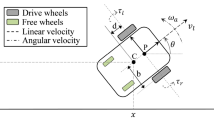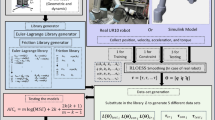Abstract
This paper is concerned with the problem of design and implementation of a robust adaptive control strategy for electrically driven robots while considering to the constraints on the actuator voltage input. The proposed approach provides a flexible design framework and stable to deal with robustness compared with many other adaptive controllers, such as halting/slowing adaption techniques and adaptively adjusting command signal, which are proposed for robotic applications. The control design procedure is based on a new form of universal approximation theory and using Stone–Weierstrass theorem, to avoid saturation besides being robust against both structured and unstructured uncertainties associated with external disturbances and actuated manipulator dynamics. Moreover, the proposed approach eliminates problems arising from classic adaptive feedforward control scheme. The analytical studies as well as experimental results produced using MATLAB/SIMULINK external mode control on a two degree of freedom electrically driven robot demonstrate high performance of the proposed control schemes.
















Similar content being viewed by others
References
Izadbakhsh, A., Akbarzadeh Kalat, A., Fateh, M.M., Rafiei, S.M.R.: A robust anti-windup control design for electrically driven robots: theory and experiment. Int. J. Control Autom. Syst. 9, 1005–1012 (2011)
Lee, C.K., Chan, W.T.: Utilization of the saturation effect on a DC motor drive with a fuzzy controller. IEEE/IAS International Conference on Industrial Automation and Control, 342–349 (1995)
Liu, G., Goldenberg, A.A.: Comparative study of robust saturation-based control of robot manipulators: analysis and experiments. Int. J. Robot. Res. 15, 473–491 (1996)
Ting, Y., Tosunoglu, S., Freeman, R., Tesar, D.: Saturation avoidance methods for serial robots operating under a failure. J. Robot. Syst. 16, 667–678 (1999)
Peng, W., Lin, Z., Su, J.: Computed torque control-based composite nonlinear feedback controller for robot manipulators with bounded torques. IET Control Theory Appl. 3, 701–711 (2009)
Z-Rio, A., Santibanez, V.: Simple extensions of the PD with gravity compensation control law for robot manipulators with bounded inputs. IEEE Trans. Control Syst. Technol. 14, 958–965 (2006)
Z-Rio, A., Santibanez, V.: A natural saturating extension of the PD with desired gravity compensation control law for robot manipulators with bounded inputs. IEEE Trans. Robot. 23, 386–391 (2007)
Aguinaga-Ruiz, E., Zavala-Rio, A., Santibanez, V., Reyes, F.: Global trajectory tracking through static feedback for robot manipulators with bounded inputs. IEEE Trans. Control Syst. Technol. 17, 934–944 (2009)
Ramirez, J.A., Santibanez, V., Campa, R.: Stability of robot manipulators under saturated PID compensation. IEEE Trans. Control Syst. Technol. 16, 1333–1341 (2008)
Santibanez, V., Camarillo, K., Valenzuela, J.M., Campa, R.: A practical PID regulator with bounded torques for robot manipulators. Int. J. Control Autom. Syst. 8, 544–555 (2010)
Loria, A., Kelly, R., Ortega, R., Santibanez, V.: On global output feedback regulation of Euler–Lagrange systems with bounded inputs. IEEE Trans. Autom. Control 42, 1138–1143 (1997)
Izadbakhsh, A., Fateh, M.M.: Robust Lyapunov-based control of flexible-joint robots using voltage control strategy. Arabian J. Sci. Eng. 39, 3111–3121 (2014). doi:10.1007/s13369-014-0949-2
Fateh, M.M.: Robust control of flexible-joint robots using voltage control strategy. Nonlinear Dyn. 67, 1525–1537 (2012)
Cheah, C.C., Liu, C., Slotine, J.J.E.: Adaptive jacobian vision based control for robots with uncertain depth information. Automatica 46, 1228–1233 (2010)
Karason, S.P., Annaswamy, A.M.: Adaptive control in the presence of input constraint. American Control conference. 1370–1374 (1993)
Annaswamy, A.M., Wong, J.E.: Adaptive control in the presence of saturation nonlinearity. Int. J. Adaptive Control Signal Process. 11, 3–19 (1997)
Purwar, S., Kar, I.N., Jha, A.N.: Adaptive control of robot manipulators using fuzzy logic systems under actuator constraints. Fuzzy Sets Syst. 152, 651–664 (2005)
Xiao, J-Z., Wang, H-R., Zhang, W., Wei, H-R.: Adaptive robotic control based on a filter function under the saturation of actuators. Int. Conf. Mach. Learn. Cybern. 283–287 (2006)
Zergeroglu, E., Dixon, W., Behal, A., Dawson, D.: Adaptive set-point control of robotic manipulators with amplitude-limited control inputs. Robotica 18, 171–181 (2000)
Dixon, W.E.: Adaptive regulation of amplitude limited robot manipulators with uncertain kinematics and dynamics. IEEE Trans. Autom. Control 52, 488–493 (2007)
Johnson, E. N., Calise, A. J.: Neural network adaptive control of systems with input saturation. Proc. Am. Control Conf. 5, 3527–3532 (2001)
Takagi, N., Oya, M., Wang, Q., Kobayashi, T.: Adaptive control scheme achieving smooth control input in the presence of input saturation. IEEE Int. Conf. Netw. Sens. Control. 238–243 (2009)
Åström, K.J., Hangander, P., Sternby, J.: Zeros of sampled system. Automatica 20, 31–38 (1984)
Tsao, T.-C., Tomizuka, M.: Adaptive zero phase error tracking algorithm for digital control. Trans. ASME J. Dyn. Syst. Meas. Control 109, 349–354 (1987)
Huang, A.-C., Chen, M.-C.: Adaptive control of robot manipulators: a unified regressor free approach. World Sci. (2010)
Izadbakhsh, A., Rafiei, S.M.R.: Endpoint perfect tracking control of robots: a robust non inversion-based approach. Int. J. Control Autom. Syst. 7, 888–898 (2009)
Kokotovic, P., Khalil, H.: Singular Perturbations in Systems and Control. IEEE Press, New York (1986)
Yao, B., Xu, L.: Adaptive robust motion control of linear motors for precision manufacturing. Mechatronics 12, 595–616 (2002)
Rudin, W.: Principles of Mathematical Analysis. McGraw-Hill, Singapore (1976)
Seraji, H.: Decentralized adaptive control of manipulators: theory, simulation, and experimentation. IEEE Trans. Robot. Autom. 5, 183–201 (1989)
Huang, A.-C., Chien, M.C.: Adaptive sliding mode control for single link flexible-joint robot with mismatched uncertainties. IEEE Trans. Control Syst. Technol. 12, 770–775 (2004)
Chien, M.C., Huang, A.-C.: Adaptive impedance control of robot manipulators based of function approximation based technique. Robotica 22, 395–403 (2004)
Huang, A.-C., Wu, S.-C., Ting, W.-F.: A fat based adaptive controller for robot manipulators without regressor matrix: theory and experiments. Robotica 24, 205–210 (2006)
Chien, M. C., Huang, A.-C.: Adaptive impedance controller design for flexible-joint electrically-driven robots without computation of the regressor matrix. Robotica. 30, 133–144 (2011)
Izadbakhsh, A., Rafiei, S.M.R.: Robust control methodologies for optical micro electro mechanical system: new approaches and comparison. 13th Power Electronics and Motion Control Conference, EPE-PEMC. 2102–2107 (2008)
Franklin, G.F., Powell, J.D., Emami-Naeini, A.: Feedback Control of Dynamic Systems. Pearson Education, 6nd edition (2011)
Astrom, K.J., Wittenmark, B.: Adaptive Control, 2nd edn. Addison-Wesley, New York (1995)
Soderdtrom, T., Stoica, P.: System Identification. Prentice Hall, Cambridge (1989)
Tutunji, T., Molhim, M., Turki, E.: Mechatronic systems identification using an impulse response recursive algorithm. Simul. Model. Pract. Theory 15, 970–988 (2007)
Kara, T., Eker, I.: Nonlinear modeling and identification of a DC motor for bidirectional operation with real time experiments. Energy Convers. Manag. 45, 1087–1106 (2004)
Acknowledgments
The authors would like to thank Dr Iman zamani for his comments on the article. They also thank Hossein salehian for his comments on the robotic mechanical design.
Author information
Authors and Affiliations
Corresponding author
Appendices
Appendix 1
In order to develop the proposed control scheme, it is convenient to view each joint as a subsystem of the entire actuated manipulator system. Toward this end, let \(V\) presented by
By this definition, the dynamic model (10) can be expressed by a collection of \(n\) second-order nonlinear dynamic which is described by following scalar differential equations:
where the subscript “i” indicates the ith element, and \(m_{ii} (q)\) is the varying effective inertia seen at the ith joint. Thus, Eq. (70) can be expressed as follows:
where
is treated as disturbance. \(d_i (q,\dot{q},\ddot{q})\) is imposed to the ith joint and contains the gravity, friction, coriolis, centrifugal torques for the ith joint, inertia coupling effects from the other joints as well. From the system point of view, (72) summarizes the coupling between the ith subsystem and the remaining subsystem. Plus and subtracting \(\ddot{q}_i \) from (71) and multiplying both sides of it by \(m_{ii}^{-1} \) yields available model, presented in Sect. 3.
Appendix 2
Proof of propositioin 1
Let \(\mho \) to be a set of continuous function on \(T\), and \(T\) is Convex set in the form of (23). Now, suppose \(\mathfrak {I}_1 (t)\) and \(\mathfrak {I}_2 (t)\) are given as
we have
Hence, \(\mathfrak {I}_1 (t)+\mathfrak {I}_2 (t)\) and \(\mathfrak {I}_1 (t).\mathfrak {I}_2 (t)\in \hbar \). Finally, for any arbitrary \(\sigma \in \mathfrak {R}\) we can get
which is also in the form of (23). So, by considering (74) and (75) we can conclude that \(\mho \) is algebra. Therefore, the first condition of Stone–Weierstrass Theorem is satisfied for \(\mho \). We show that \(\mho \) separates points on \(T\). We choose the parameters of the \(\mathfrak {I}(t)\) in the form of (23) as follows:
Since \(t_1 \ne t_2 \), then \(\mathrm{e}^{-t_1 }\ne \mathrm{e}^{-t_2 }\) and therefore the second condition is also verified. To show that \(\mho \) vanishes at no point of \(T\), we simply observe that any system in the form of (23) with \(\omega _{i} =0\), \(\theta _{i} =0\), and \(c_i >0\) has the property of
Hence, \(\mho \) vanishes at no point of \(T\). Thus the three conditions of the Stone–Weierstrass theorem are satisfied. Therefore the result follows by Stone–Weierstrass Theorem. \(\square \)
Rights and permissions
About this article
Cite this article
Izadbakhsh, A., Fateh, M.M. Real-time robust adaptive control of robots subjected to actuator voltage constraint. Nonlinear Dyn 78, 1999–2014 (2014). https://doi.org/10.1007/s11071-014-1574-z
Received:
Accepted:
Published:
Issue Date:
DOI: https://doi.org/10.1007/s11071-014-1574-z




